THE isolated coastal valleys of northern Peru, some fifteen hundred years ago, were the home of a people whose realistic art in clay was never equaled by any other native potters in the western hemisphere. Like so many other products of American aboriginal culture, it appears full-formed, its earlier phases, there or elsewhere, yet to be discovered.
Fundamentally, its forms are few: large flaring bowls, discoidal dippers incurved to narrow mouths, ollas or jars and round-bodied water-bottles with stirrup spouts. These are decorated with genre painting, or the body may be modeled into human or animal forms, the spout adjusted to any convenient angle. To the makers of this red-and-white painted ware, formerly called Proto-Chimu, nothing was too intimate, nothing too trivial in their daily life for portrayal: a woman spinning, a boy plucking a thorn from his foot, a bodily mutilation of interest to the pathologist. In portrait vessels of surprising power and beauty, ancient chieftains live on, proud, masterful, self-reliant.

Museum Object Number: 39-20-8
Image Number: 20410

Image Number: 20413
The University Museum has recently received seventy-five pieces of this ancient pottery, the generous gift of Mrs. George W. Childs Drexel. The collection was made in Peru, many years since, but is now available for study, for the first time.
At the time of the conquest of Peru, the Incas had extended their dominion over the coastal land, but, according to their custom, leaving to the ruling chieftain a certain amount of authority. He bore the title of Chimo, from which has been derived the name for the people and their culture. The language which they spoke was Muchic, which was probably the proper name of the people themselves. At this lime their pottery was moulded, either a red ware, or black, rebaked in smothered fires. Rarely a two-colored vessel appears in this Late Chimu period. Though somewhat hybridised, it retained many of the traits of the ancestral Early, or Proto-Chimu ware, which among Peruvian archaeologists is coming to be called Mochica.
A Middle Chimu period, suggested by Kroeber, who separated out certain probable characteristics, is gaining recognition as research progresses. A small number of pieces of Mrs. Drexel’s collection may be assigned to this Middle Chimu, or Middle Mochica period. The remainder with one exception are Early Chimu.
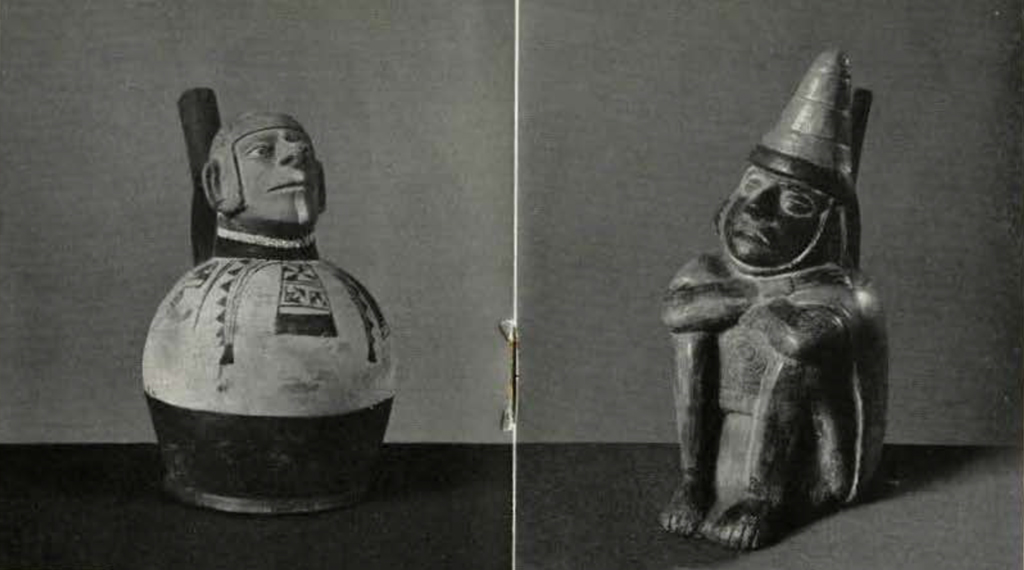
Museum Object Numbers: 39-20-34 / 39-20-11
Image Numbers: 20418, 20412
The great majority of Mochica figure vessels represent men. Two notable exceptions are the Potato Mother, and the Mani or Peanut Woman, the former fecund with progeny bursting from the potato “eyes,” the latter reposing in her shell. Small wonder that the potato should have been personified and probably deified! Although maize and beans were also cultivated in ancient times, it is said that “half the Indians of Peru had no other bread” than the potato, of which many varieties were known to the Chimu, besides wild and bitter ones. Certain kinds were even used for dye. Fresh, dried and, in the colder highlands, frozen and desiccated, the potato was the staff of life of the Andean peoples from coastal valleys to mountain slopes (Plate VI).
Portrait head vessels, always of men, offer some variation in the wearing of the head-cloth-for theirs was a land framed by mountain, sea and deserts and swept by sand-laden winds. Face-painting and perhaps tatuing are shown, and one face presents a mutilation of the lips (Plate V).
The figure vessels display the costume; the shirt or tunic, often elaborately patterned; the loin cloth; cuffs or wristlets. The head-dress adds new features: a band with an uplifted hand at each side, terraced horns, large discs, a pillow, cowls, caps, helmets, animal skins split to encompass the head, leaving the creature’s head in front and tail in rear. Ear discs and pendants, nose ornaments and bead necklaces are in evidence. Over the right shoulder hangs the small handsome bag, which contained the indispensable coca, which served to make fatigues endurable.

Image Number: 20427

Image Number: 20428
There are two masked figures, one presenting an owl. It is recorded that the Mochica greatly admired the owl for its beautiful eyes, the falcon for its lightness and the condor for its size.
A lively portrait of a monkey wears a collar, suggesting that he was a pet, while another bottle shows the monkey, or man in monkey mask, in more contemplative mood, clasping a jar and laying his head upon it.
One vessel presents a kneeling man, clasping to his breast a large-billed bird. Another effigy bottle shows a man holding an animal, probably a dog, which seems to have been the only domesticated animal in those early times. The llama, which belongs to the highlands, first appears in Late Chimu pottery A hybrid figure of a dog-headed man, or perhaps a man wearing a dog mask, sits with a drum between his knees.
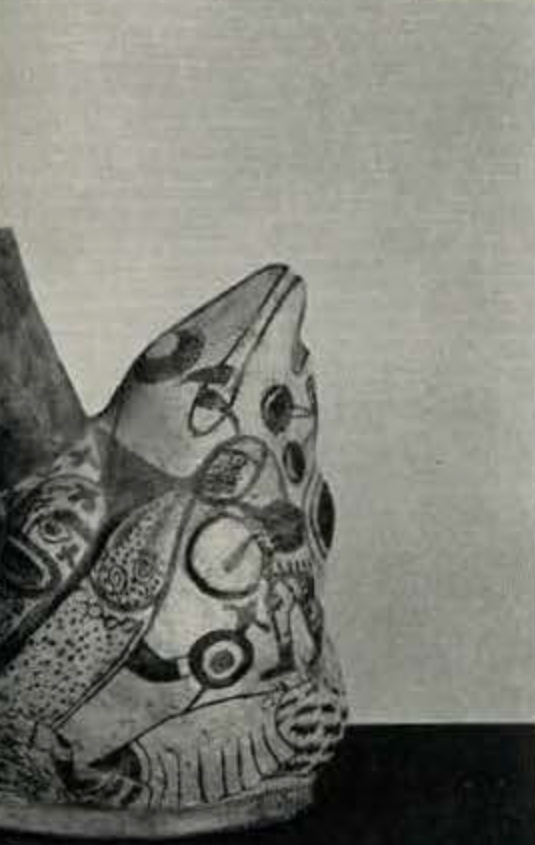
Image Number: 20425
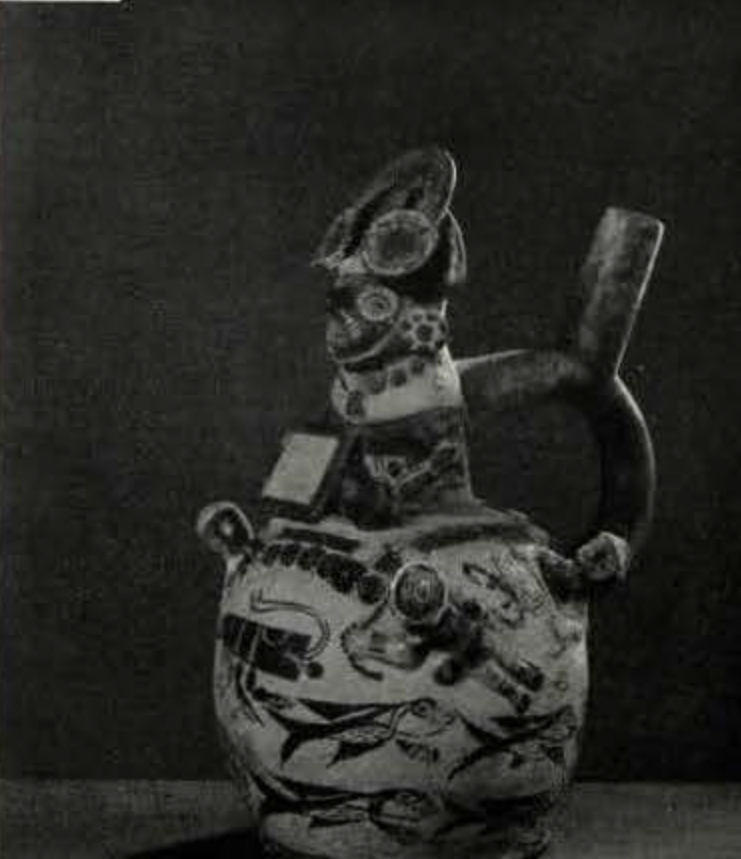
Image Number: 20424
The Mochica had other musical instruments, cymbals of bivalve shells, pan-pipes of reed, pottery trumpet and the great Triton-shell trumpet. Capping the top of one of the water bottles, appears an important personage, judging by his head-dress, blowing such a Triton trumpet. An early missionary and chronicler, Father Miguel Cabello de Balboa, attempting to trace that ever-elusive thing, the origin of the people, obtained this legend:
“There came from northern Peru to the valley where lies Lambayeque, a father of families, named Naymlap, with his wives and concubines and retainers, with a fleet of balsas (the primitive vessel constructed of bundles of the light balsa wood) . He brought in his company many people who followed him as their captain and leader. Those among them who were of the greatest bravery were their officials, who were forty in number, including such men as Pita Zofi, who was the trumpeter or player upon certain great shells that are much esteemed among the Indians. Another man was Nimacola, who was in charge of the litter and throne; another was Ninagostoc, in whose care was the drink of that lord, after the fashion of a butler….”
This legend, describing conditions no longer primitive but as they must have been in late pre-Inca times, may yet have in its essentials considerable antiquity. It is possible to imagine our important trumpeter on the vessel to be the legendary Pita Zofi, and to find on another bottle, Ninagostoc, whose care was the drink of that lord.

Image Number: 20423

Image Number: 20421
Behold him wearing massive head-dress, about to lift the lid from a great jar which rests on a narrow strip, criss-crossed by lines. A lizard in relief crawls upward on the strip, while below him on either side is the sea, teeming with ferocious fish. In fact, the guardian of the jar actually stands upon the back of such an one, while a smaller and less important man seems to be trying to crawl up from the back of another monster fish.
There are two stirrup-spouted vessels which show a man seated cross-legged on a throne. These, according to characteristics proposed, would fall in the Middle Chimu period.
One of the most delightful pieces of the collection is a bottle which portrays a means of travel more suitable to river than to ocean voyages. A warrior, bird-masked, high-helmeted with copper crescent, and armed with shield and stone-headed war-club, is seated on a raft, made lighter by a row of round floats fore and aft, is being guided and propelled by four swimming attendants, each holding a rope attached to a corner of the raft. At breast and at each side of girdle, these human propellers wear round floats, which proves that water-wings were no new invention. Crabs, a lobster, snail-shells, a school of fishes with curious inflated pouches and an unpleasant nondescript perhaps account for the pained expression on the faces of the swimmers (Plate V).

Museum Object Number: 39-20-27
Image Number: 20414

Museum Object Number: 39-20-35
Image Number: 20420
Two of the finest pieces of Mrs. Drexel’s gift are effigy vessels representing warriors. Both are kneeling on the left knee and holding heavy stone-headed maces. Both wear tunics and elaborate helmets. The one, of the typical red and white ware of the Early Mochica, is probably a portrait, so vivid is the face, a warrior belonging to the order of the jaguar, as indicated by the handsome spotted tunic, the split jaguar skin headband with its head above his forehead, and the high disc with cat in outline (Plate VII).
The other warrior figure is of black ware, but so fine is its execution that it may be considered as an example of the rare bucchero ware of the early period. He wears the high copper crescent on his helmet and the quincunx or “five-spot” appears to be his insignia, since it occurs on shield, ear discs and helmet-knobs.
Both square and round shields were used, probably by different orders. On the flaring lip of a rattle-bottomed bowl, four shields are shown, alternating in form, each with its appropriate device and with accompanying maces, pike-staves, sling and apparel. If aught were known of the cosmogony of these ancients, it might be found that the two forms of shield are related to the widely distributed concept of the round sky and the square earth, the Above and the Below.
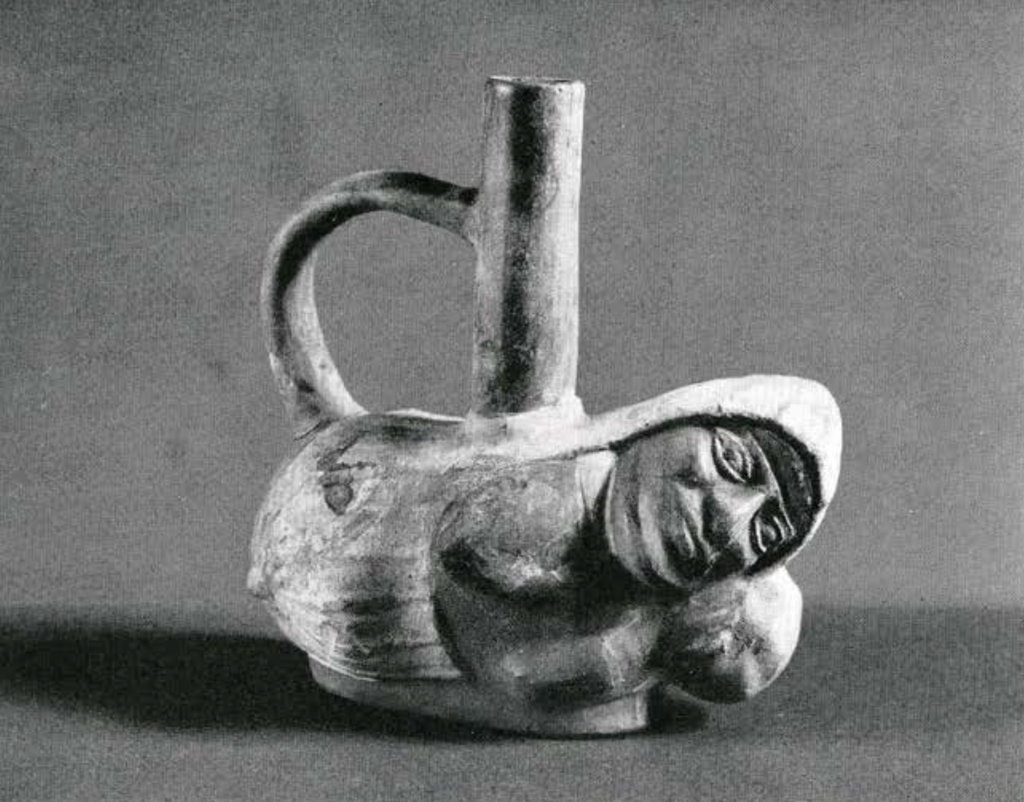
Museum Object Number: 39-20-33
Image Number: 20417
The Mochica seem to have joyed in battle, so often does it occur in their painted scenes. Note the warrior, in tunic and pointed helmet, face, feet, ankles and knees painted black, striding forth with shield and mighty war-club. Above him flies the war-bird, ally and protector. Note, on another bottle, the belted Man-falcon, in similar war-paint, striding to battle with shield and weapon. The sea-eagle or falcon has been identified as the war-god of the Muchica of whom Father Antonio de la Calancha wrote:
“The Chimos Indians …. are bellicose Yuncas who inhabit the plains and keep an idol in their army whom they call ‘god of battles’ and offer to him the spoils of their enemies, sacrificing to him their lives and offering him their blood.”
An amusing expression of the war instinct is to be seen on the stirrup-spouted vessel where two ferocious and impossible insects(?) are engaged in lively combat. Even the animals of the deep appear with shield and war-club. As curious a piece as ever came from the brain and hand of potter is the vase of the giant frog, if frog it be, with its wicked fangs. On one side an alligator (?) with shield and club, confronts a masked man with what appears to be a disc-drum. Below the man, who somehow suggests a diver, is a giant univalve shell from which the snail, or some later occupant, stretches its hideous body to the mouth of the frog. On the other flank of the frog, among weird predatory creatures of the abyss lies a grinning human skull. The scene suggests some forgotten epic of an ancient hero-sorcerer, like the Babylonian Gilgamesh, contending with the mighty denizens of the deep.

Museum Object Number: 39-20-48
Image Number: 20429

Image Number: 39-20-32
Image Number: 20415
A strange pantheon must have been theirs: the fierce orca-god in the sea, the bountiful sea itself, deified maize, peanut and potato on land, the ancestral stones of the wayside, the falcon war-god in the sky, and, above all, the inconstant moon, responsible for growing things, ruler of the elements and of ocean tides, mightier even than the sun upon whom the lunar shadow fell.
Mrs. Drexel’s gift, so rich in these painted scenes as well as in modeled forms, adds greatly to the University Museum’s Peruvian collections.
H. N. W.
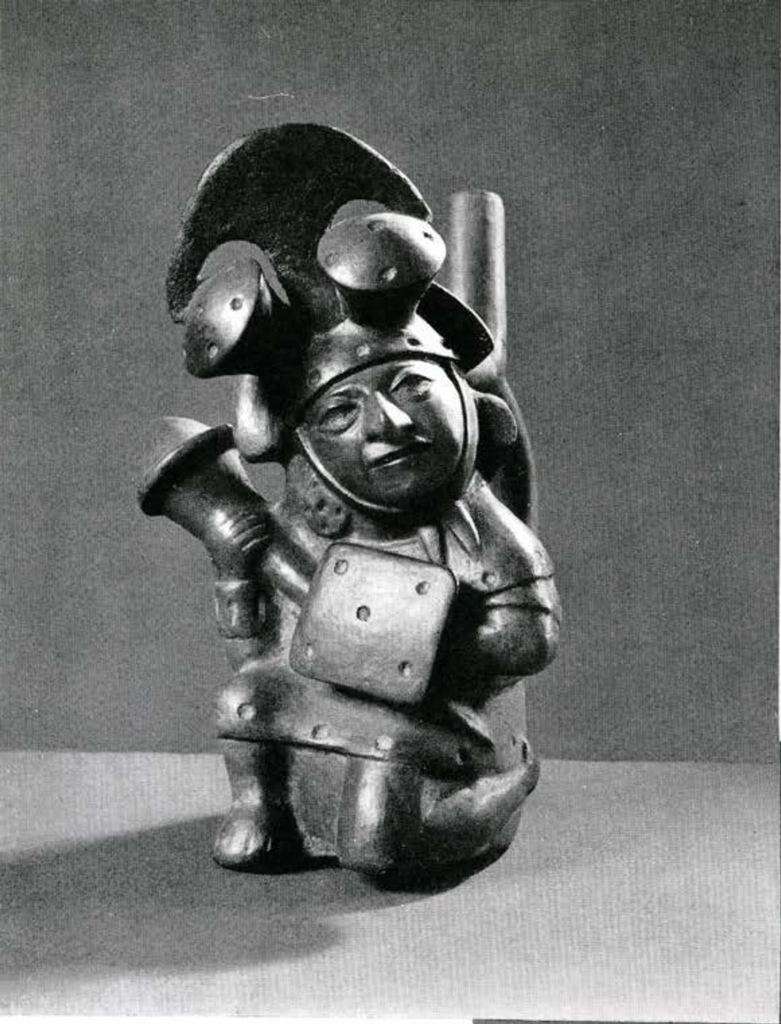
Museum Object Number: 39-20-70
Image Number: 20431

Museum Object Number: 39-20-9
Image Number: 20411

